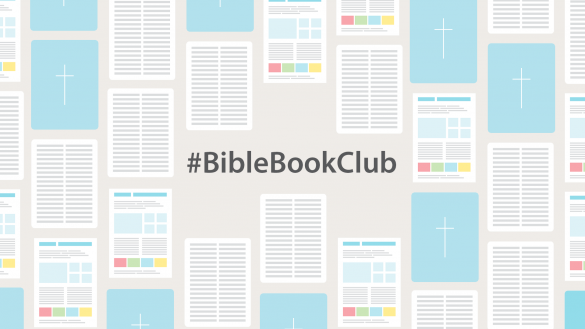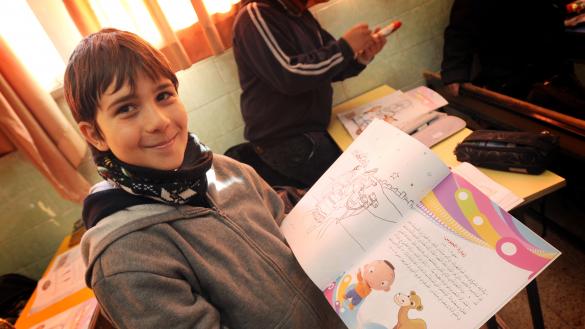What Is the Best Understandable Bible to Read Next to the King James Version?
Which is the best Bible translation?
One of the nigh asked questions almost the Bible is 'what is the all-time translation?'
Information technology all depends on who you lot are and what you will be using it for. It can help to know a few bones facts virtually translations...
How do I cull my Bible translation?
Many people discover that they need more than 1 Bible and use different ones for dissimilar occasions. Due to the large number of translations available online for free it is very easy to have access to a wide range of different translations.
First of all, consider how yous'll be reading the Bible...
I'm new to the Bible
You might like to beginning with a translation that avoids too much technical language. Expect for i described as 'dynamic equivalent'**.
I'll be reading the Bible aloud
A translation that focuses more on dynamic equivalence**.
I'll be reading with other people
Decide whether it would aid yous to take the same version as everyone else or a different one and then that you tin see how dissimilar translators have translated the passage you lot are reading.
I desire to study a passage in depth
A translation that focuses on formal equivalence* will be most helpful.
I'll be reading big sections at a time (eastward.yard. following a Bible reading plan)
A translation that focuses more on dynamic equivalence**.
I desire to get a sense of the complexities of the passage and what translators have wrestled with to create their translations
Read a range of translations, choosing at least two formal equivalence* translations.
* A formal equivalence, word-for-word translation gives priority to what the original language says and how information technology says it. Information technology aims to be a literal translation.
** A dynamic equivalence, thought-for-thought translation gives priority to what the text ways. Information technology aims to brand the text every bit readable for a modernistic audience as possible.
Translation guide
Click on the title to find out more most each translation. You'll detect that some of the aforementioned comments appear under pros and cons – this is because some people regard something as a positive, while others regard exactly the same thing as a negative.
- Engagement first published: 1995
- What kind of translation? Dynamic equivalence – still a translation but is oft very colloquial and renders the original linguistic communication loosely
- Average reading historic period? ten+
- Gender neutral linguistic communication?Yep
- Often stated pros of the translation:
- Designed for people who do not know Bible 'jargon'
- Easy to understand and to read out loud
- Intended for people who struggle to read other translations
- In 1996 the CEV won the Crystal Mark award from the Apparently English Campaign
- Ofttimes stated cons of the translation:
- Sometimes simplifying Bible jargon changes what it was originally maxim (or only communicates part of what was meant)
- Those who know the Bible already find that its richness has been lost
- At that place is very little verse in the translation
- Sample poetry: 'If we have all we need and see ane of our own people in need, we must have pity on that person, or else we cannot say we dear God.' (i John 3.17)
See Contemporary English Version Bibles in the store
- Engagement first published: 2001
- What kind of translation? Formal equivalence – literal, staying close to the original sentence structure but irresolute it where meaning is compromised
- Boilerplate reading historic period? 15+
- Gender neutral language?No
- Ofttimes stated pros of the translation:
- A revision of the RSV, undertaken past various iconic evangelical theologians
- Has tried to proceed some of the best-loved passages in a translation that is close to the KJV
- Avoids inclusive language
- Oft stated cons of the translation:
- For some, the evangelical theology that has guided the translation is problematic
- Avoids inclusive language
- Some find the sentence structure hard to empathize
- Sample poesy: 'But if anyone has the earth's appurtenances and sees his brother in demand, yet closes his middle confronting him, how does God's dear abide in him?' (1 John 3.17)
See English Standard Version Bibles in the shop
- Date outset published: 1976
- What kind of translation?Dynamic equivalence – still a translation but is often very vernacular and renders the original language loosely
- Average reading age? 12+
- Gender neutral language?Yes
- Often stated pros of the translation:
- Designed to be accessible to (and is very popular among) non-native English speakers, especially in Africa and the Far East.
- Its line drawings are iconic and assistance with understanding the text
- An easy-to-read and understand version
- Oft stated cons of the translation:
- Oft criticised for lack of depth in its phrasing
- Some feel that, occasionally, information technology goes likewise far from the original text in its attempt to communicate meaning
- Sample verse: 'If we are rich and see others in demand, yet close our hearts against them, how can we merits that we dear God?' (ane John 3.17)
Meet Good News Bibles in the shop
- Date kickoff published: 1966
- What kind of translation? Dynamic equivalence – does non endeavor to follow original sentence structure and focuses on what the text means
- Average reading age? 16+
- Gender neutral language?No
- Oftentimes stated pros of the translation:
- A Catholic Bible containing the 73 books of the Cosmic canon
- Literary in style with some well-known writers involved such as JRR Tolkien
- Some passages are beautifully poetic
- Often stated cons of the translation:
- Some merits it is more than a paraphrase than a translation (translated from French)
- Criticised for being insufficiently literal
- Sample verse : 'If a man who was rich enough in this globe's goods saw that 1 of his brothers was in need, only closed his heart to him, how could the beloved of God be living in him?' (1 John 3.17)
- Engagement commencement published: 1611
- What kind of translation? Formal equivalence – literal, staying shut to the original sentence construction but changing it where meaning is compromised
- Average reading historic period? 17+
- Gender neutral language? No
- Often stated pros of the translation:
- Beautiful poetic language
- Linguistic communication that has influenced many phrases in mod English
- Very close to the original text
- Oftentimes stated cons of the translation:
- Primitive language that many people practise not understand
- Based on the Hebrew and Greek texts available in the 16th century.
- Some words used in the KJV at present have very different meanings (eastward.g. the discussion suffer every bit in 'endure the picayune children')
- Sample poesy: 'But whoso hath this earth'southward good, and seeth his brother take need, and shutteth up his bowels of compassion from him, how dwelleth the love of God in him?' (1 John 3.17)
See King James Version Bibles in the shop
- Engagement first published: 1971
- What kind of translation?a paraphrase, i.e. not translated directly from the the original languages
- Average reading age? 12+
- Gender neutral language?No
- Frequently stated pros of the translation:
- One of the very few genuine paraphrases, based on the American Standard Version translation
- One of the earliest accessible versions of the Bible
- Careful to communicate the meaning of each passage
- Often stated cons of the translation:
- One of the very few 18-carat paraphrases
- The linguistic communication is not designed to be elegant
- Sometimes the verses or passages are given unusual interpretations.
- Sample verse: 'But if someone who is supposed to be a Christian has money enough to live well, and sees a brother in need, and won't help him – how can God'southward dear be within him?' (ane John iii.17)
- Date first published: 2002
- What kind of translation?Dynamic equivalence – nonetheless a translation but is ofttimes very colloquial and renders the original language loosely
- Boilerplate reading historic period? 9+
- Gender neutral language?Yes
- Often stated pros of the translation:
- A fresh easy-to-read, idiomatic translation
- It oftentimes presents a different insight to a passage
- It captures some of the passion of the original
- Ofttimes stated cons of the translations:
- Its colloquial style works for some and not for others
- Its idioms are quite American and British readers can find this difficult
- The translation is very costless, which can pb to questions about its accuracy
- Sample verse: 'If you come across some brother or sister in need and accept the means to exercise something about information technology just turn a cold shoulder and do nothing, what happens to God'south dearest? It disappears. And you made it disappear.' (ane John 3.17)
- Engagement first published: 1971 (updated in 1995)
- What kind of translation?Formal equivalence – very literal, equally close to the original sentence structure every bit possible
- Boilerplate reading age? sixteen+
- Gender neutral language?No
- Ofttimes stated pros of the translation:
- Considered by many to exist the 'most literal' translation
- especial care was taken to reverberate the same verb tense as in the original
- Often stated cons of the translation:
- Ofttimes nigh impossible to understand in English
- Conservative theology affects translational decisions
- Sample verse: 'But whoever has the world'south goods, and sees his blood brother in demand and closes his middle against him, how does the dearest of God abide in him?' (1 John 3.17)
- Date first published: 1996
- What kind of translation? Dynamic equivalence – does not endeavor to follow original judgement structure and focuses on what the text means
- Average reading historic period? 7+
- Gender neutral language? Yes
- Often stated pros of the translation:
- All the advantages of the NIV but easier to read
- Designed so that people can go on to read the NIV if/when they want to
- Ane of the clearest and easy to read translations around
- Often stated cons of the translation:
- It does sometimes slip more into interpreting the text than only translating information technology
- Some avoid it because of its advertised depression reading age
- Sample verse: 'Suppose someone sees a brother or sister in demand and is able to help them. And suppose that person doesn't accept pity on these needy people. Then how can the dearest of God be in that person?' (ane John 3.17)
- Engagement first published: 1978 (updated in 2011)
- What kind of translation? Mixed dynamic and formal equivalence – attempts to adopt a midpoint between staying close to the original text and communicating its pregnant in a way that is easy to understand
- Boilerplate reading historic period? 12+
- Gender neutral language? No (1978), Aye (2011)
- Often stated pros of the translation:
- One of the few translations that tries to residuum literal translation with an emphasis on meaning
- Is often clear and easy to read
- Has tried to keep an accent on literary beauty, making it a good translation for reading in church
- Frequently stated cons of the translation:
- It endeavour to maintain clarity has caused it to introduce words that are not in the original
- Some people exercise non like its style of writing, finding it bland or lacking in poetry
- Sample verse: 'If anyone has material possessions and sees a brother or sister in need but has no pity on them, how tin the love of God be in that person?' (1 John iii.17)
- Appointment first published: 1985
- What kind of translation?Mixed dynamic and formal equivalence – attempts to prefer a midpoint betwixt staying close to the original text and communicating its meaning in a way that is easy to empathise
- Boilerplate reading age? xiii+
- Gender neutral language?A little
- Often stated pros of the translation:
- A heavily revised version of the Jerusalem Bible
- Introduces some inclusive language
- Attempts to make the translation a more literal translation than the Jerusalem Bible
- Oftentimes stated cons of the translation:
- The attempt to be more than literal loses some of the poetry of the Jerusalem Bible
- Introduces some inclusive linguistic communication
- Sample verse: 'If anyone is well-off in worldly possessions and sees his brother in demand only closes his eye to him, how can the honey of God exist remaining in him?' (1 John 3.17)
- Date first published: 1982
- What kind of translation? Formal equivalence – literal, staying close to the original sentence construction but changing it where meaning is compromised
- Average reading age? 12+
- Gender neutral linguistic communication? No
- Often stated pros of the translation:
- A maintenance of the poetic language of the KJV updated into modern English
- Uses as much as possible the aforementioned version of the original text as the KJV did
- Often follows the translation in the KJV
- Often stated cons of the translation:
- Its endeavour to exist very literal can make information technology hard to read
- Largely based on the Hebrew and Greek texts available in the 16th century.
- Often follows the translation in the KJV
- Sample poesy: 'Just whoever has this world's goods, and sees his brother in demand, and shuts upward his center from him, how does the dear of God abide in him?' (1 John 3.17)
Come across New King James Version Bibles in the store
- Engagement start published: 1996
- What kind of translation?Dynamic equivalence – still a translation but is often very vernacular and renders the original language loosely
- Boilerplate reading age? 11+
- Gender neutral language?Yes
- Oft stated pros of the translation:
- Began as a revision of The Living Bible but became a full translation from the original language
- Kept The Living Bible'southward emphasis on accessibility
- Changes some metaphors from the Bible into more understandable phrases (due east.g. existence 'in sorrow' rather than 'beating their breasts')
- Often stated cons of the translation:
- Its emphasis on accessibility sometimes makes it feel a long mode from the original
- The alter of metaphors into more modern linguistic communication ofttimes changes their meaning more than what was intended
- Non one of the strongest amongst the accessible translations
- Sample verse: 'If someone has enough money to live well and sees a blood brother or sister in need but shows no compassion – how can God's love be in that person?' (1 John 3.17)
- Date first published:1989
- What kind of translation?Formal equivalence – literal, staying close to the original sentence structure but changing it where meaning is compromised
- Average reading historic period?16+
- Gender neutral linguistic communication?Aye
- Oft stated pros of the translation:
- Uses up-to-date language (in detail it uses less archaic language for God)
- The Erstwhile Testament reflects Jewish interpretations of the text
- Used more than up-to-date versions of the Hebrew and Greek text
- Tried hard to avert 'male-simply' language
- Often stated cons of the translation:
- The Old Testament was translated to reflect Jewish interpretations of the text. The problem for some here is prophecies that were later seen to be about Christ. Some remember their translation should ever reflect this; others that they should exist translated in such a way as the original audience might have understood them
- Sometimes its choice of inclusive language obscures connections in the text
- Sample verse : 'How does God's dearest abide in anyone who has the world's goods and sees a brother or sister in demand and yet refuses help?' (ane John iii.17)
Encounter New Revised Standard Version Bibles in the shop
- Appointment outset published: 1989
- What kind of translation? Dynamic equivalence – attempts to adopt a midpoint between staying shut to the original text and communicating its meaning in a mode that is easy to sympathize
- Average reading historic period?11+
- Gender neutral linguistic communication?Yes
- Oft stated pros of the translation:
- One of the few modern translations to originate in Great britain
- Aims for a mix of accuracy, poetry and comprehension
- It is peculiarly good for reading in public
- Often stated cons of the translation:
- It isn't widely used and and so is quite hard to get hold of
- Because it doesn't follow the best known translations, sometimes its phrases sound unusual
- Sample poesy: 'If we have all we need and run across one of our own people in need, nosotros must take pity on that person, or else nosotros cannot say we love God.' (1 John 3.17)
- Appointment commencement published: 1952
- What kind of translation?Formal equivalence – literal, staying close to the original sentence structure merely changing information technology where meaning is compromised
- Boilerplate reading historic period? 17+
- Gender neutral language? No
- Often stated pros of the translation:
- Intended to be a readable though literal translation (at the time)
- The Old Testament was translated to reverberate Jewish interpretations of the text
- Used more up-to-date versions of the Hebrew and Greek text
- Often stated cons of the translation:
- Linguistic communication has moved on and it is no longer upwards-to-date
- The Old Testament was translated to reflect Jewish interpretations of the text. The problem for some here is prophecies that were afterward seen to be about Christ. Some think their translation should always reflect this; others that they should be translated in such a way as the original audience might have understood them.
- Sample verse: 'But if whatsoever ane has the world's goods and sees his brother in need, yet closes his middle against him, how does God's love abide in him?' (1 John 3.17)
See Revised Standard Version Bibles in the shop
Called your translation? Check out these resources...

The Bible Course
Whether you lot're well versed in Scripture or just starting out on the journey, The Bible Course offers a superb overview of the world's all-time-selling book.

My Bible
'When my mum was pregnant with me, my parents read Psalm 121 a lot. Information technology's comforting and very beautiful. It gives an atmosphere of peace and support. Then at that place was a burn down in my mum's house about a week before I was due...'

Bible Book Club
Love books? Dearest book clubs? Welcome to Bible Book Lodge, helping you read the Bible with your friends – one book at a time.

Glossary
Unsure of the meaning of a give-and-take or phrase in the Bible? Bank check our glossary of terms.

What we're doing
Detect out how we work and where nosotros work to bring the Bible to life for communities all over the world.
lauderdalenatithem.blogspot.com
Source: https://www.biblesociety.org.uk/explore-the-bible/which-is-the-best-bible-translation/
0 Response to "What Is the Best Understandable Bible to Read Next to the King James Version?"
ارسال یک نظر